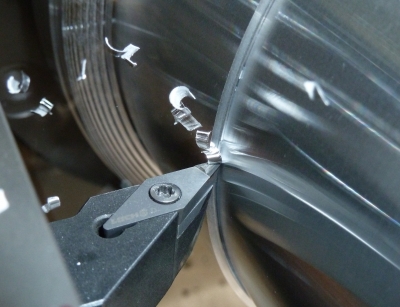
LACH DIAMOND can look back on 20 years of experience in the development of PCD chipbreakers. The first CO-type patent was issued on January 26, 1999: A laser cut chip groove for PCD materials.
Practice has shown, however, that chipbreakers with a so manufactured chip groove have proven to be only suitable to a limited extent for a process-reliable, controlled chipbreaking process of long chipping aluminum alloys.
An active chipbreaker was the final solution. It had to show outstanding performance during rough machining, as well as fine finishing. LACH DIAMOND's PCD »3D-active« chipbreaker was born.
While CO-type chipbreakers only redirect the chips, the new »3D-active« chip breaker will already guide chips with a cutting depth (ap) of 0.01 mm. The cutting depth can be increased up to the maximum length of the cutting edge.
Shown is a PCD cutting insert with active chipbreaker »3D-active« turning aluminum with a cutting depth (ap) of 2.0 mm.
Contact Details
Related Glossary Terms
- alloys
alloys
Substances having metallic properties and being composed of two or more chemical elements of which at least one is a metal.
- aluminum alloys
aluminum alloys
Aluminum containing specified quantities of alloying elements added to obtain the necessary mechanical and physical properties. Aluminum alloys are divided into two categories: wrought compositions and casting compositions. Some compositions may contain up to 10 alloying elements, but only one or two are the main alloying elements, such as copper, manganese, silicon, magnesium, zinc or tin.
- chipbreaker
chipbreaker
Groove or other tool geometry that breaks chips into small fragments as they come off the workpiece. Designed to prevent chips from becoming so long that they are difficult to control, catch in turning parts and cause safety problems.
- polycrystalline diamond ( PCD)
polycrystalline diamond ( PCD)
Cutting tool material consisting of natural or synthetic diamond crystals bonded together under high pressure at elevated temperatures. PCD is available as a tip brazed to a carbide insert carrier. Used for machining nonferrous alloys and nonmetallic materials at high cutting speeds.
- turning
turning
Workpiece is held in a chuck, mounted on a face plate or secured between centers and rotated while a cutting tool, normally a single-point tool, is fed into it along its periphery or across its end or face. Takes the form of straight turning (cutting along the periphery of the workpiece); taper turning (creating a taper); step turning (turning different-size diameters on the same work); chamfering (beveling an edge or shoulder); facing (cutting on an end); turning threads (usually external but can be internal); roughing (high-volume metal removal); and finishing (final light cuts). Performed on lathes, turning centers, chucking machines, automatic screw machines and similar machines.






